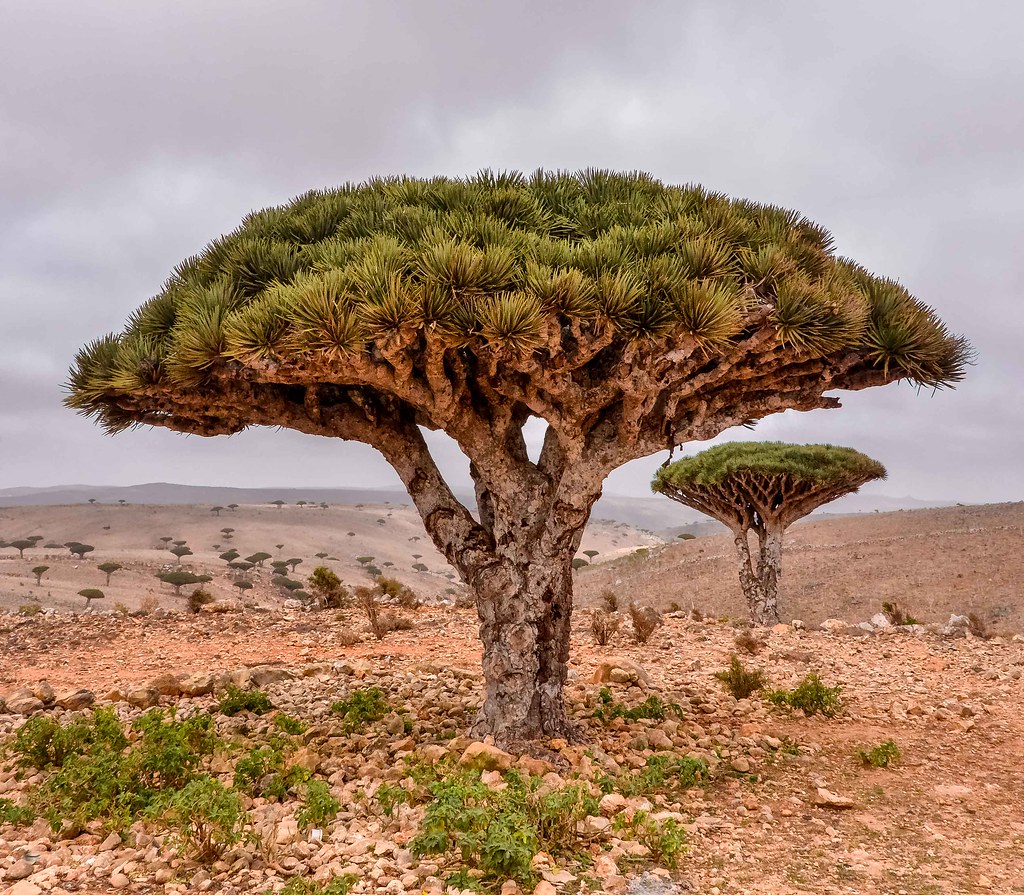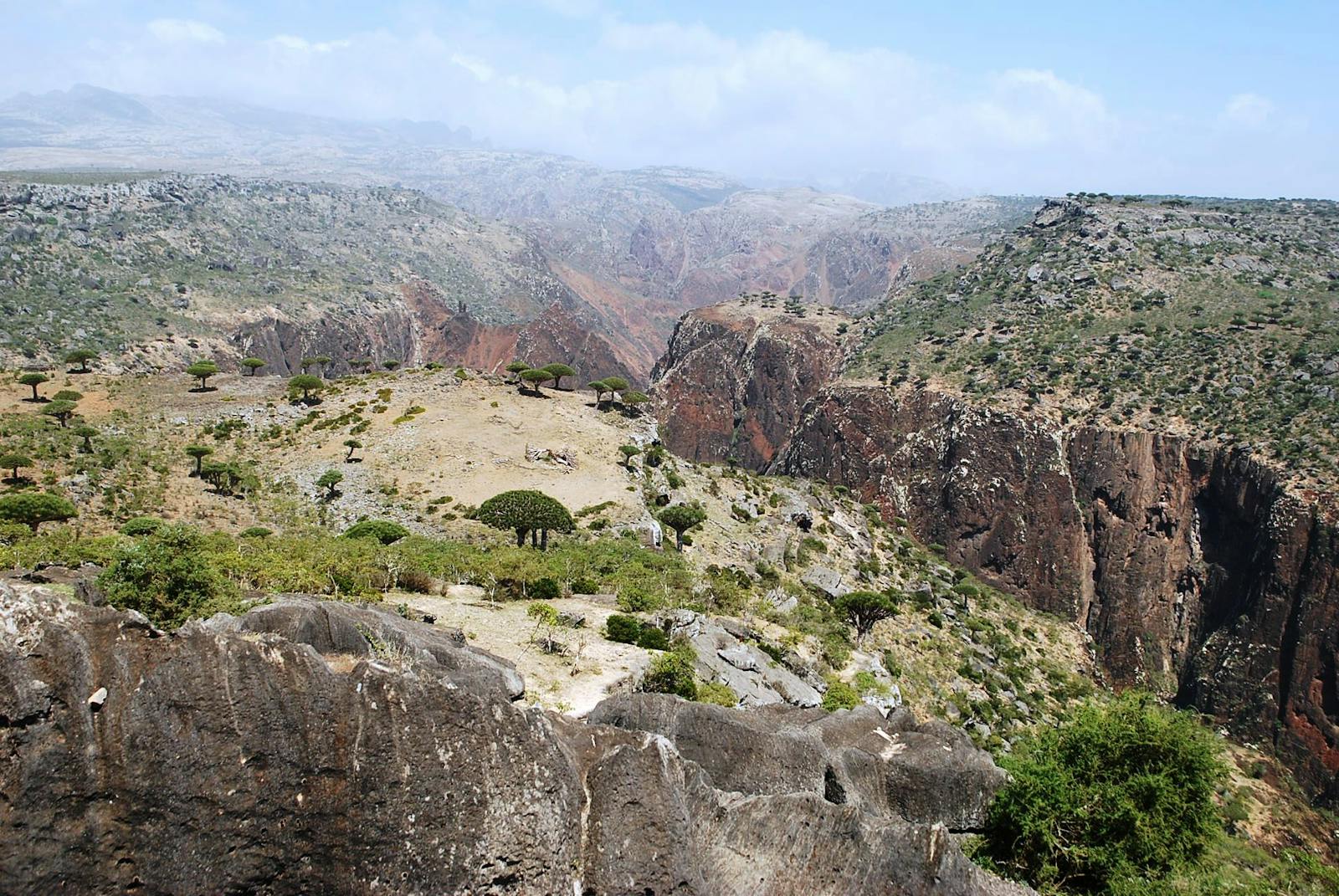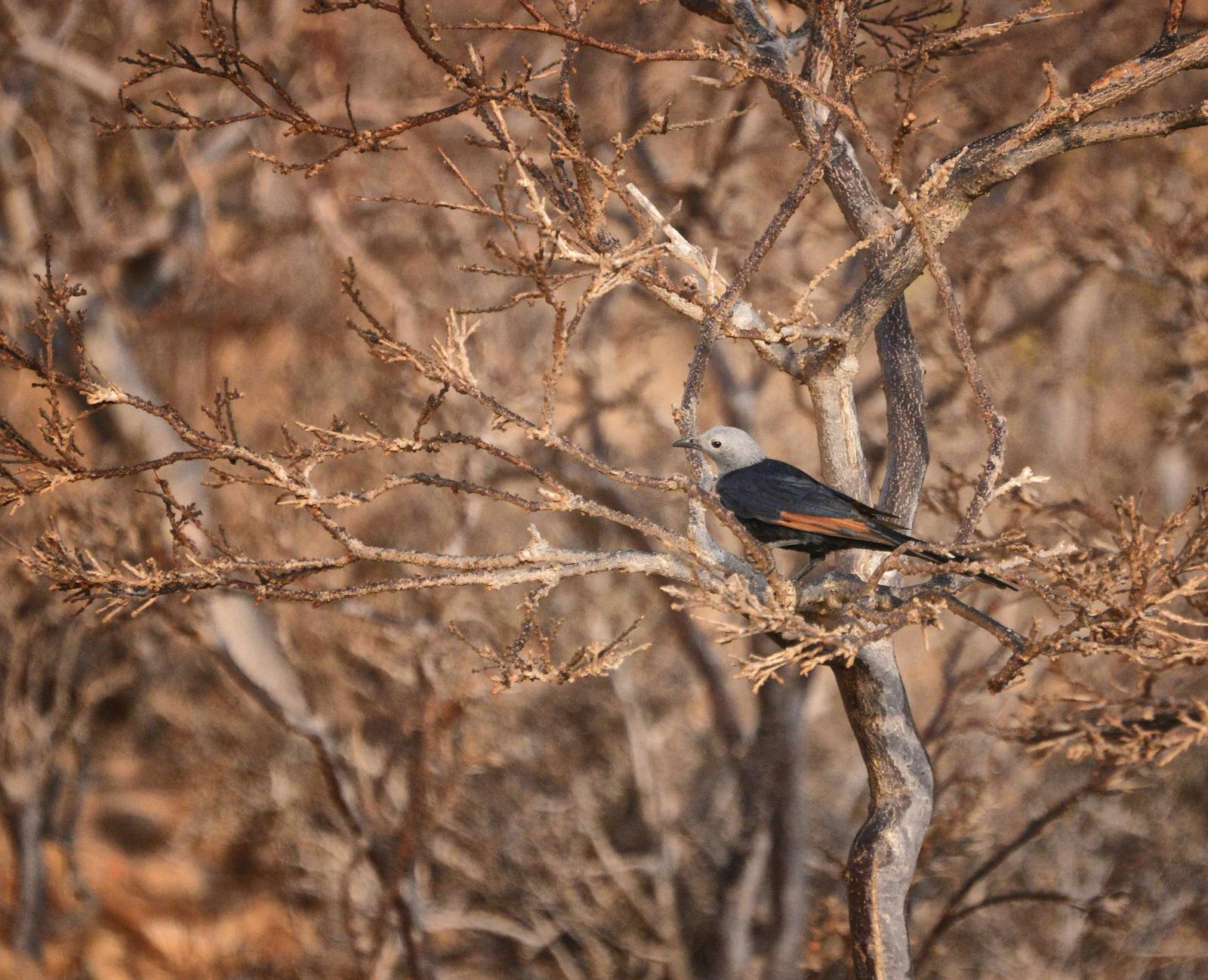Socotra Island Xeric Shrublands
The ecoregion’s land area is provided in units of 1,000 hectares. The protection goal is the Global Safety Net (GSN1) area for the given ecoregion. The protection level indicates the percentage of the GSN goal that is currently protected on a scale of 0-10.
Bioregion: South Red Sea & Gulf of Aden Coastal Drylands (AT22)
Realm: Afrotropics
Ecoregion Size (1000 ha):
383
Ecoregion ID:
105
Conservation Target:
92%
Protection Level:
10
States: Yemen
The most striking endemic species of Socotra Island is the Dragon’s blood tree, which can withstand the arid climate in this ecoregion by collecting water on its umbrella-shaped dense crowns. Moisture from the humid air or fog condenses on the large leaf area and drips down the tree, providing essential moisture to the soil and consequently facilitating the growth of understorey vegetation. The tree also provides shade which reduces soil evaporation and enriches the soil through leaf litter.
The ecoregion covers a small archipelago of islands approximately 240 km east of the Horn of Africa and 480 km south of the Arabian Coast. Socotra is the largest of the islands, and the other main islands are Abd al Kuri, Semhah, and Darsa. The dominant landscape feature of Socotra Island is an extensive plateau of Cretaceous limestone averaging 300 to 700 m in elevation. The plateau rises near the Hagghier Mountains in the northwest (maximum elevation 1,519 m), which then declines abruptly at the extreme western portion of the island, falling in steep escarpments to the coastal plains or directly into the ocean.
The climate is strongly influenced by both the southwest (April–October) and northeast (November–March) monsoons. The southwest monsoons bring extremely strong, hot, and dry winds from Africa. The winter monsoon begins in November and lasts until March. Mean annual rainfall varies from about 150 mm on the coastal plains to more than 1,000 mm in the mountains. Mist and dew are more important to the water supply than monsoonal rain, especially in the high altitude mountain belt. Mean temperatures range from 27 to 37oC maximum and 17 to 26oC minimum along the coastal plain. It is substantially cooler in the Hagghier Mountains.
The coastal plains and low inland hills consist of open deciduous shrubland dominated by the endemic Croton socotranus and scattered trees of Euphorbia arbuscular, Dendrosicyos socotranus, and Ziziphus spina-christi. Grasses and herbs develop after sufficient rainfall. The most widespread vegetation type is distinctive, species-rich, open shrubland found on the coastal foothills and the limestone escarpments, with dominant endemics species Jatropha unicostata. Succulent trees such as Euphorbia arbuscular, Dendrosicyos socotranus and Adenium obseum and emergent trees such as Boswellia spp., Sterculia africana, and Commiphora spp. are also present.

The flagship species of the Socotra Island Xeric Shrublands ecoregion is the dragon's blood tree. Image credit: Rod Waddington, Creative Commons
Socotra is within the Somali-Masai regional centre of endemism. Biologically, the Socotran Archipelago is well known for its assemblage of endemic and unusual species. Some of the plants on Socotra represent the last surviving members of their genus. The limestone plateau and the Hagghier Mountains are the richest areas for endemic plant species. Euphorbia abdelkuri grows only on Abd al Kuri. This endangered plant is an unusual Euphorbia, known for its spineless columnar stems, all linked by a single rootstock. Plant species in the drier parts of this ecoregion evolved morphological and physiological adaptations to cope with the dry climate and fierce monsoonal winds. Adenium socotranum has a special cell sap cycling within the caudex which prevents overheating. The succulents display several morphological adaptations to lack of water and heat. Plant bodies are globular or columnar, with reduced surface areas that decrease transpiration. Glaceous wax surfaces and microanatomical epidermal emergences reflect radiation. Umbrella-shaped shrubs form dense thickets, with all plants reaching the same height, a structure that protects them from strong winds.
There are only seven terrestrial mammals in the ecoregion, most of which are introduced, although a bat (Rhinopoma sp.) and a shrew (Suncus sp.) are possibly endemic. Endemic bird species include the island cisticola, Socotra warbler, Socotra bunting, Socotra sunbird, and Socotra starling. At least 30 bird species are known to breed on Socotra, including a significant population of Egyptian vultures. Most terrestrial reptiles are endemic, including short worm lizard, Socotran chameleon, and Socotran racer.
The original climax vegetation on Socotra has been altered through a combination of grazing and the cutting of wood for fuel. The more densely populated coastal plains are more degraded than the interior plains or the mountains. However, the island’s isolation has helped to curb degradation and preserve the natural habitats. From April to October, the violent monsoon winds prevent the approach of any airplanes or ships. The majority of the ecoregion is protected in the Socotra archipelago world heritage site (4,105 km2).
The main threats to biodiversity are excessive woodcutting for timber and fuel in the vicinity of the main settlements, unplanned infrastructural development on Socotra—especially the coastal zone, and an expanding population of goats and, to a lesser extent, cattle. The small populations of some of the endemic resident bird species and endemic plants are indicative of the threats to their long-term survival on the island. This is particularly true for some of the breeding seabirds, whose numbers have been reduced by rats and other introduced predators. Up until this year, the island has remained mostly out of reach from the impacts of the Yemeni war. However, the recent deployment of military troops onto the island risks both wildlife and flora.
The priority conservation actions for the next decade will be to: 1) improve local capacities in dealing with invasive alien species and implement a quarantine system to assess new arrivals and prevent potential invasions; 2) create awareness as to sustainable agroforestry improvement techniques, for example, time of seed collection, choice of planting sites, and nursery practices; and 3) involve local communities in forest protection and management activities.
Citations
1. Burgess, N., Hales, J.A., Underwood, E., Dinerstein, E., Olson, D., Itoua, I., Schipper, J., Ricketts, T. and Newman, K. 2004. Terrestrial ecoregions of Africa and Madagascar: a conservation assessment. Island Press.
2. Rejžek, M., Svátek, M., Šebesta, J., Adolt, R., Maděra, P. and Matula, R. 2016. Loss of a single tree species will lead to an overall decline in plant diversity: Effect of Dracaena cinnabari Balf. f. on the vegetation of Socotra Island. Biological Conservation. 196, pp.165-172.
3. Senan, A.S., Tomasetto, F., Farcomeni, A., Somashekar, R.K. and Attorre, F. 2012. Determinants of plant species invasions in an arid island: evidence from Socotra Island (Yemen). Plant ecology. 213(9), pp.1381-1392.
4. Attorre, F., Taleb, N., De Sanctis, M., Farcomeni, A., Guillet, A. and Vitale, M. 2011. Developing conservation strategies for endemic tree species when faced with time and data constraints: Boswellia spp. on Socotra (Yemen). Biodiversity and Conservation. 20(7), pp.1483-1499.






